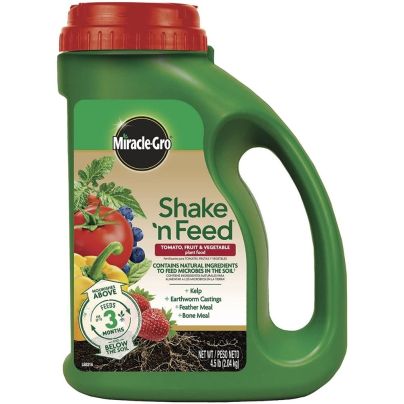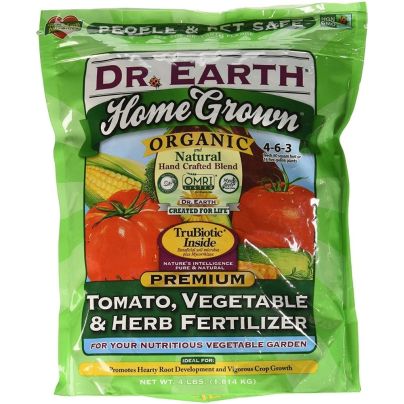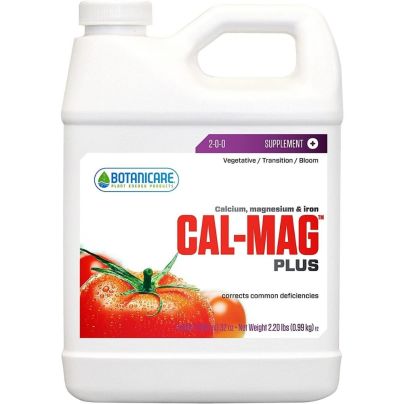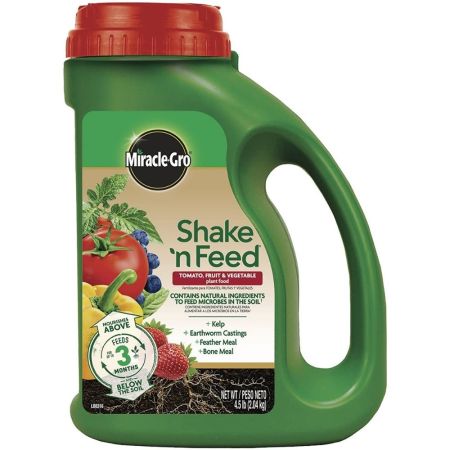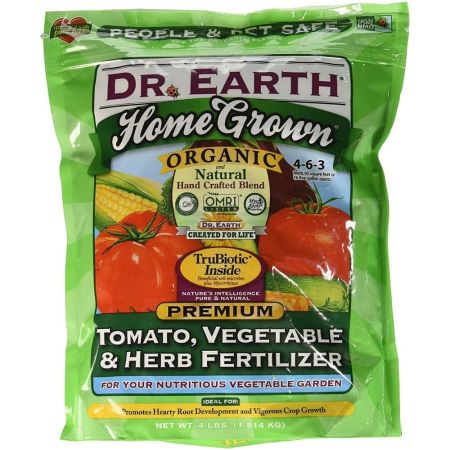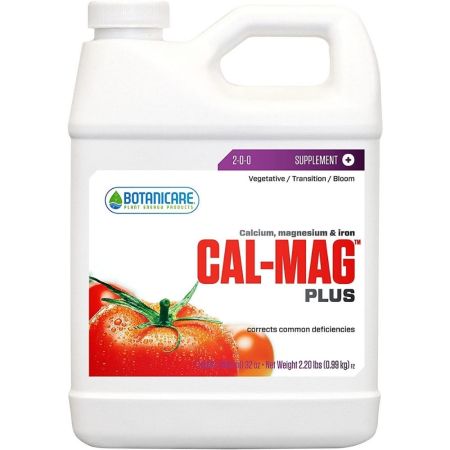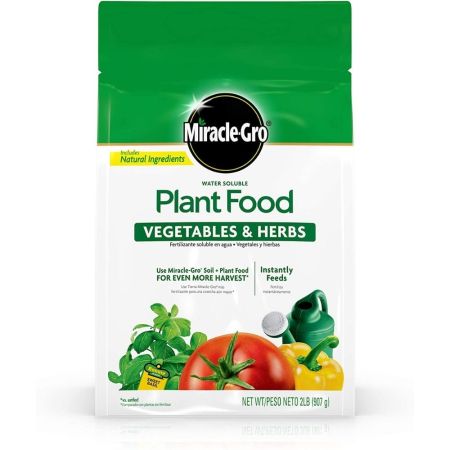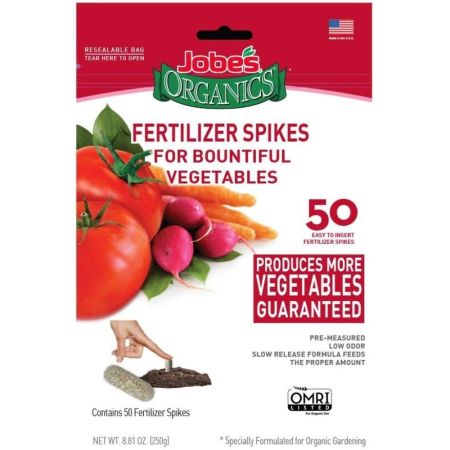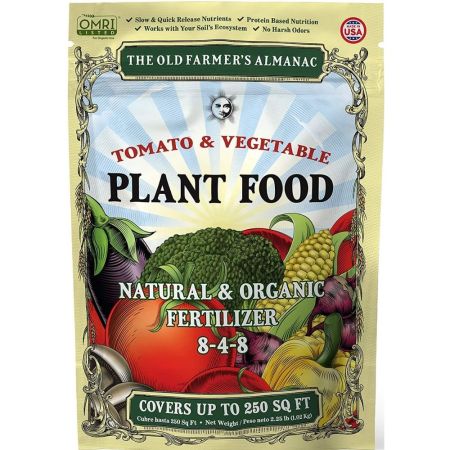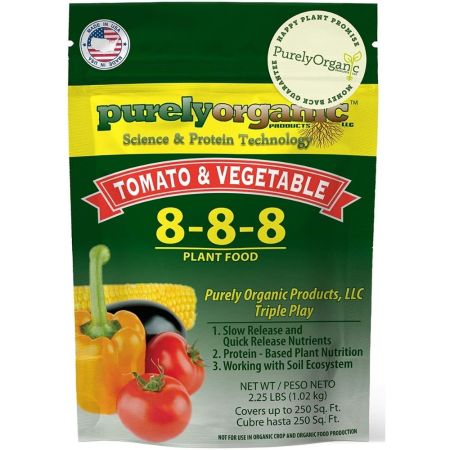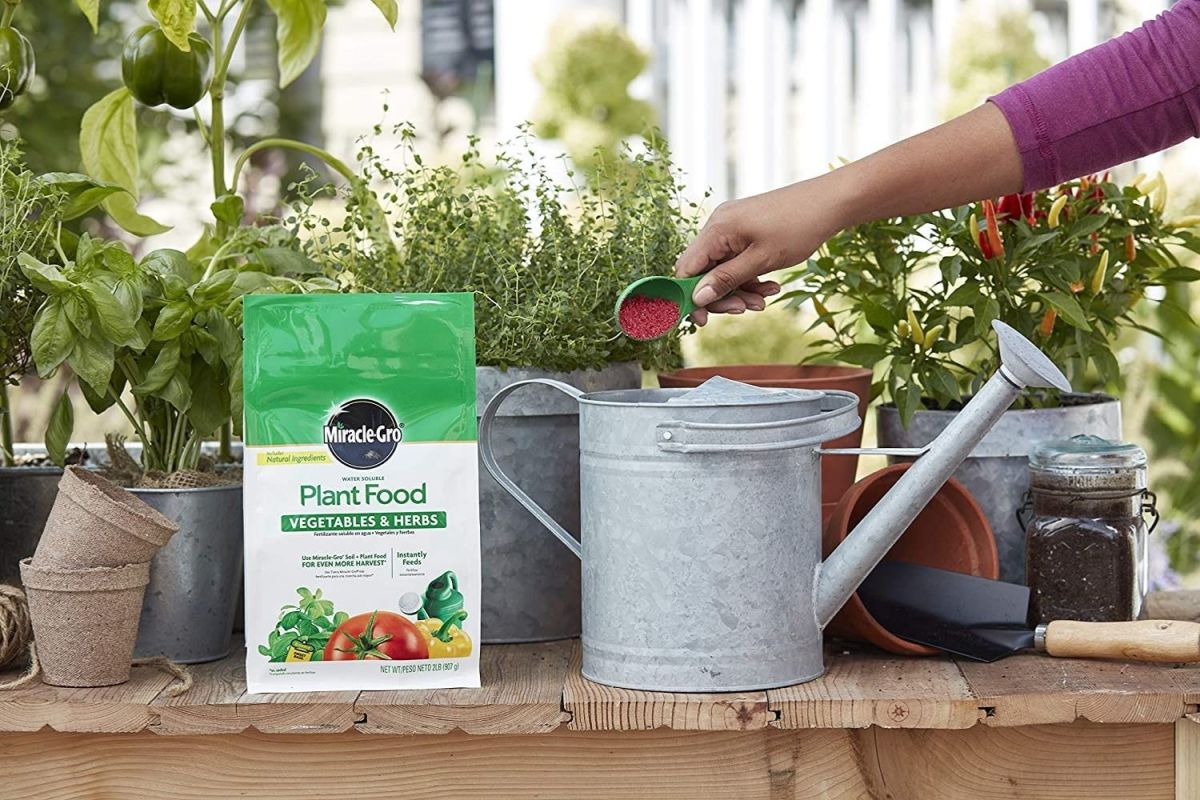
We may earn revenue from the products available on this page and participate in affiliate programs. Learn More ›
Few things are as satisfying as growing vegetables and picking them at their ripest, healthiest, and tastiest. As vegetable plants grow, their roots extend deep into the soil, absorbing the nutrients necessary for vegetable production.
While most soil types—except heavy clay—are suitable for growing vegetables, the soil should drain well and carry plenty of nutrients. By adding a fertilizer designed to produce vigorous plants, plentiful blossoms, and large specimens, gardeners can maximize their vegetable harvest.
The best fertilizer for peppers and other veggies will vary depending on the current soil conditions, garden location (ground level, raised bed, or container-grown), and how much time the gardener has to tend the plants. Ahead, learn what to look for in a veggie garden fertilizer, and find out why the following products are beneficial for most backyard gardens.
- BEST OVERALL: Miracle-Gro Continuous Release Plant Food 3002610
- BEST ORGANIC: Dr. Earth Organic Tomato, Vegetable & Herb Fertilizer
- BEST LIQUID: Botanicare HGC732110 Cal-Mag Plus, A Calcium
- BEST WATER-SOLUBLE: Miracle-Gro Water Soluble Plant Food Vegetables
- BEST SLOW-RELEASE: Jobe’s Organics Vegetable & Tomato Fertilizer Spikes
- BEST STARTER: The Old Farmer’s Almanac Organic Tomato & Vegetable
- ALSO CONSIDER: Purely Organic Products Tomato &Vegetable Plant Food
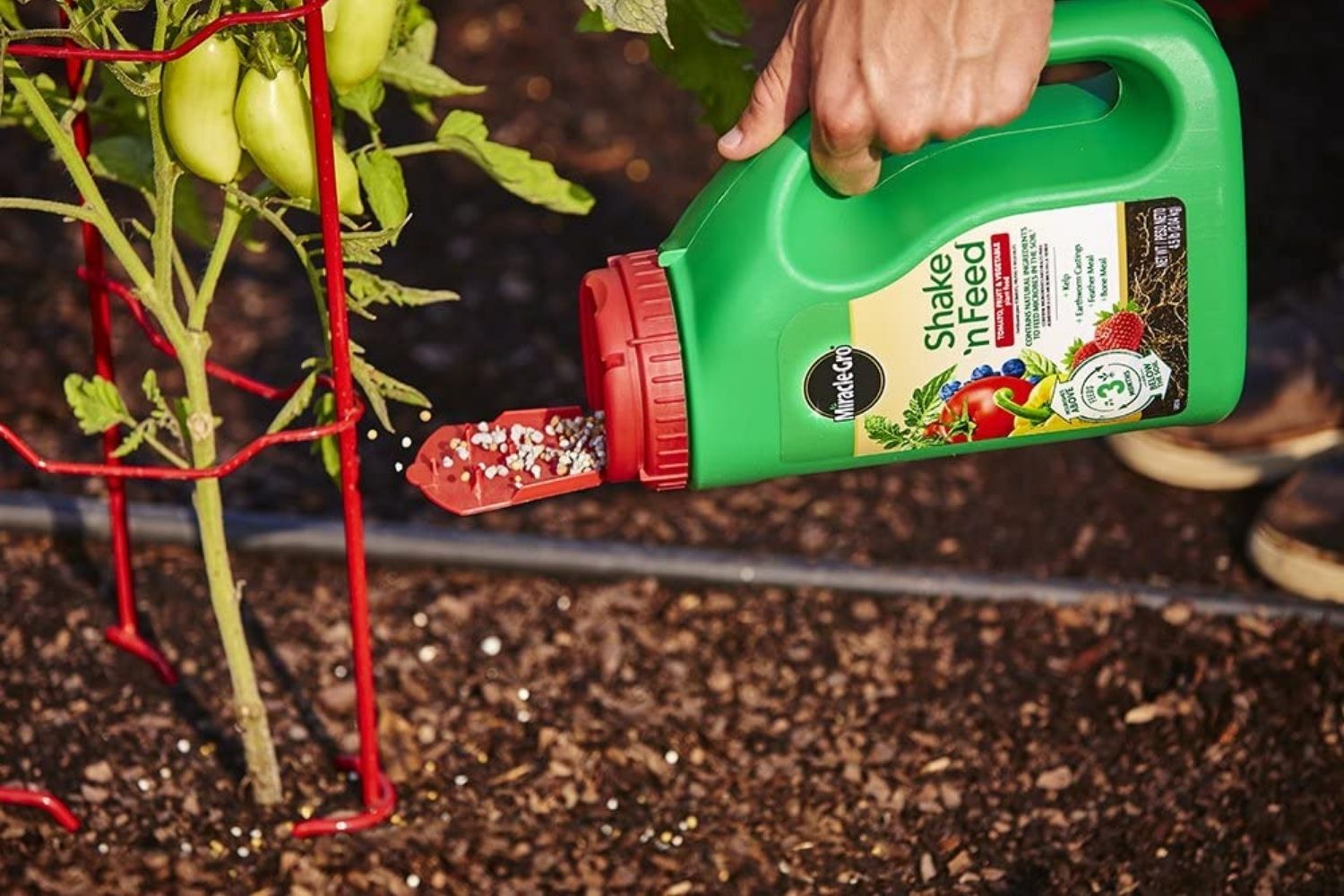
What to Consider When Choosing the Best Fertilizer For Peppers
One of the all-time favorites in the summer vegetable garden is the bell pepper, grown in various colors, including green, red, yellow, and even purple. It’s not the only type of pepper plant gardeners grow, however.
Other types of peppers—all belonging to the nightshade (Solanaceae) family—come in a wide range of sweet and fiery-hot types and are prized for adding flavor and a bit of a bite to dinner entrees. Fortunately, the same fertilizer types used for other veggies, such as tomatoes, are also beneficial for producing bumper crops of peppers.
Organic vs. Inorganic
All veggie fertilizers supply nutrients that will help boost plant growth and vegetable production, but gardeners can opt for one of two main types: organic or inorganic. Both can be beneficial.
- Organic: Many home gardeners prefer using organic fertilizer on fruits and vegetables because all the fertilizer ingredients come from natural sources, such as bone meal, worm castings, and composted poultry manure.
- Inorganic: Rather than natural ingredients, inorganic fertilizers contain chemicals and synthetic ingredients. Inorganic fertilizers work in the same manner as organic fertilizers, but they’re usually slightly less expensive because they’re easier to produce. Commercial growers with many plants often use inorganic fertilizers, and the products are also available in home-use sizes for the backyard gardener.
Chemical Fertilizer Content
Commercial fertilizers bear a label that indicates the various amounts of three main nutritional components—nitrogen (N), phosphorus (P), and potassium (K) by weight. For example, a bag of 10-10-10 fertilizer contains 10 percent of each of the three nutrients by weight.
Many veggie and pepper fertilizers contain a formulation with more potassium or phosphorus than nitrogen, such as a 5-10-10 blend or a 3-6-4 blend, which will encourage robust plant growth while focusing most of the plant’s energy on blossom and vegetable production. Others feature equal amounts of each of the three nutrients.
For the most part, any fertilizer meant for veggies will be a good choice for peppers, tomatoes, and even herbs. If using a fertilizer doesn’t produce the desired effect, gardening books often recommend testing the garden soil to pinpoint possible soil deficiencies that need correcting. The goal when growing vegetables isn’t to produce the tallest, bushiest plants, but rather to produce sturdy plants that produce plenty of large, tasty vegetables.
Some pepper and tomato fertilizers also contain other nutrients, such as calcium or magnesium, to help treat common soil deficiencies and create healthier plants.
Form
Feeding peppers and other veggies is a simple gardening task, and individual gardeners have their own preferences concerning the type of fertilizer they prefer.
- Liquid: Available in either ready-to-use or concentrated form, liquid fertilizers are easy for plant roots to readily absorb, but they also pass through the soil quickly, especially if the vegetable is a container-grown one, resulting in liquid fertilizer washing right out the drain holes. Some liquid fertilizers can also be sprayed directly on a plant’s foliage, offering a quick feed.
- Granular: Designed to release nutrients slowly, granular fertilizers resemble tiny pebbles or grains, and gardeners incorporate them within the top few inches of soil. When the gardener waters the plant, the granules slowly break down, providing a continuous supply of nutrients for weeks.
- Water-soluble: This fertilizer also comes in a granular (or powdered) form, and it dissolves in water for application. Gardeners can opt to mix it in a watering can and then apply it around the plant’s base or use it with a hose feeder connected to a garden hose to distribute the fertilizer while watering.
- Spikes: Like granular fertilizers, spikes contain hard, dry ingredients that slowly release nutrients into the soil. They’re beneficial for gardeners who prefer to use a one-and-done approach rather than fertilizing every two weeks or so as might be necessary with liquids and water-soluble types. They’re also well suited to raised beds and container-grown plants where other fertilizer types can wash out quickly.
Growing Stages
Peppers and other vegetable plants are fast growers, going from seed to harvest in approximately four months or less, so they will benefit from frequent feedings.
Some fertilizers recommend feeding during the transplant stage to get the new plants off to a hardy start and then feeding every few weeks, depending on the fertilizer type. Be aware that some chemical fertilizers recommend stopping feeding up to 10 days before harvesting produce.
Soil Condition
Peppers and other vegetables will grow in many types of soil, but they’ll do best in lightweight soil that won’t compact. Heavy clay soil has plenty of natural nutrients, but it’s so dense that plant roots can’t spread well. If the soil is heavy, just adding fertilizer won’t correct the whole problem.
The gardener should also consider amending the soil by adding natural ingredients, such as compost, perlite, or peat moss, all of which will lighten the soil, allow it to drain better, and help increase root development.
Our Top Picks
To qualify as a top pick, a vegetable fertilizer should contain the nutrients necessary to help peppers and other veggie plants reach their full potential. It should come with easy-to-follow application instructions, and it should dissolve completely and quickly if it’s a water-soluble product.
While the best fertilizer for peppers and veggies will depend on soil conditions and the individual gardener’s preference, the following products are top performers. Any can benefit a summer vegetable garden.
Best Overall
Miracle-Gro Continuous Release Plant Food 3002610
With a time-release formulation and added calcium, Miracle-Gro 3002610 Shake ‘N Feed vegetable fertilizer helps produce robust pepper, tomato, and cucumber plants. Gardeners only have to apply it once every three months.
This Miracle-Gro fertilizer also contains micronutrients that enrich poor soils. This 10-5-15 formula, plus the inclusion of calcium, helps form strong cell walls in the plants while reducing the risk of diseases related to calcium deficiency.
The granulated fertilizer comes in a 4.5-pound, easy-to-apply shaker container that home veggie growers should sprinkle around the plants’ bases at the rate of 4 tablespoons per square foot of soil. Avoid shaking the granules on plant foliage. This continuous-feed fertilizer is well suited for use in garden plots and containers.
Pros
- Time-release formula requires applying only once every 3 months
- Added calcium and micronutrients to enrich soil
- Comes in shaker container for easy application
- Good choice for both container-grown and plot-grown peppers
Cons
- Requires scratching granules into soil
- Natural, but not organic; avoid fertilizing within 10 days of harvest
Best Organic
Dr. Earth Organic Tomato, Vegetable u0026 Herb Fertilizer
Dr. Earth Organic Vegetable Fertilizer offers a rich 4-6-3 formulation that’s chock-full of organic ingredients, including fishbone meal, bone meal, alfalfa meal, and kelp flour, to offer peppers and other veggies the natural nutrients they need—without chemicals.
The product also contains 7.5 percent calcium to help enrich the soil and promote healthy cell growth so plants are better able to resist drought and other calcium related issues.
When planting peppers or tomatoes, incorporate 1.3 cups of Dr. Earth granules per every 10 square feet of soil, or at the rate of 0.5 cups of granules for every 0.5 cubic feet of growing medium for container-grown veggies.
Work the granules into the top couple of inches of soil. For the best results, reapply Dr. Earth fertilizer every two months during the growing season. The package contains 4 pounds of fertilizer.
Pros
- Granular, organic fertilizer for edibles like peppers
- Includes fishbone meal and other natural ingredients, no chemicals
- Contains added calcium
- Only need to apply every 2 months during season
Cons
- Requires working granules into soil when applying
- Smell of ingredients can attract dogs to containers
Best Liquid
Botanicare HGC732110 Cal-Mag Plus, A Calcium
For those wanting a foliar spray (meaning the product is applied directly to a plant’s leaves) as well as a soil fertilizer, check out Botanicare’s HGC732110 Cal-Mag Plus Plant Supplement. The formula can be diluted at the rate of 1 teaspoon of Cal-Mag per gallon of water and put in a sprayer for spraying directly on the leaves of peppers and other veggie plants.
This 2-0-0 formulation doesn’t contain phosphorus or phosphate, but it includes 3.2 percent calcium, 1.2 percent magnesium, and 0.1 percent iron, making it beneficial for reducing the blossom-end rot that can occasionally plague tomatoes and peppers.
Cal-Mag Plus is also suitable for veggies grown in hydroponic systems by mixing it at the same ratio. The fertilizer contains a proprietary blend of other trace minerals designed to produce an abundance of blossoms and large vegetable specimens. The product comes in a 1-quart container, and other sizes might be available.
Pros
- Concentrated foliar spray or soil fertilizer
- Contains calcium, magnesium, and trace minerals
- Helps prevent blossom-end rot and encourages abundant fruiting
Cons
- Liquid concentrate must be diluted in water before use
- Supplement to a balanced fertilizer, so additional (but worthwhile) step
Best Water-Soluble
Miracle-Gro Water Soluble Plant Food Vegetables
The water-soluble Miracle-Gro vegetable and herb fertilizer comes in granular form but quickly dissolves in water, which works well for use in a watering can or a hose-type garden feeder.
Its 18-18-21 formulation encourages strong root development and robust plant growth in addition to producing increased blossoms. Dissolve the granules at the rate of 1.5 tablespoons per 1.5 gallons of water.
When using a hose-type garden feeder, follow the directions on the feeder—the 2-pound bag will fertilize up to 800 square feet of garden. This high-nutrient fertilizer is suitable for vegetables and herbs, and gardeners should reapply it every seven to 10 days for the best results.
Pros
- Packaged as granules, but they dissolve quickly in water
- Formula encourages strong root development and robust growth
- Also increases blossom production
- Apply every week to 10 days in watering pail or hose sprayer
Cons
- Requires nearly weekly application for best results
- Does not contain calcium
Best Slow-Release
Jobe's Organics Vegetable u0026 Tomato Fertilizer Spikes
Perhaps the simplest of fertilizers, Jobe’s Organics Vegetable & Tomato Fertilizer comes with 50 fertilizing spikes. Gardeners insert the spikes in the soil around the plants. The spikes gradually dissolve, providing a consistent stream of slow-release nutrients that last up to six weeks before new spikes are necessary.
This 2-7-4 formulation encourages heavy blooming and helps produce large, delicious tomatoes and peppers. It’s also an organic fertilizer, containing feather meal, bone meal, and sulfate of potash, so gardeners need never worry about the vegetables’ health value.
For best results, use these spikes when new plants are set in the garden (or container) and every eight weeks after that. Insert approximately four spikes for a plant with an 8-inch spread and eight spikes for a plant with a 12-inch spread, then water after insertion.
Pros
- Slow-release formula that dissolves gradually from spikes
- Feeds for up to 6 weeks
- Formulated to encourage blooming and large fruits
- Certified organic ingredients
Cons
- More time needed to drive spikes into the ground
- Dogs might be attracted to spikes
Best Starter
The Old Farmer's Almanac Organic Tomato u0026 Vegetable
Get new veggie plants off to an optimal start with The Old Farmer’s Almanac Organic vegetable fertilizer that growers can add during transplanting and after that to create a healthy environment for pepper and tomato plants.
This 8-4-8 formulation will encourage strong root development and boost foliage, blossom, and veggie production. It comes in granular form for sprinkling on the soil at the rate of 1.5 tablespoon per square foot of soil when transferring young vegetable plants to the garden or containers.
For the healthiest plants and a large harvest, repeat application every six to eight weeks. This organic fertilizer contains soybean meal, feather meal, bone meal, blood meal, and sulfate of potash. It comes in a 2.25-pound package that will effectively treat up to 250 square feet.
Pros
- Excellent starter fertilizer when transplanting peppers and other vegetables
- Encourages strong root development and boosts foliage growth
- Only needs reapplying every 6 to 8 weeks
- Certified natural ingredients
Cons
- Granules should be worked into ground at time of feeding
- Could lead to mold in soil
Also Consider
Purely Organic Products Tomato u0026Vegetable Plant Food
One treatment of Purely Organic Products Tomato &Vegetable Plant Food will feed peppers, corn, and other types of vegetables for up to eight weeks before a reapplication is necessary.
This organic product contains only natural ingredients, such as feather meal, blood meal, and soybean meal, in a balanced 8-8-8 formulation to help develop healthy roots and produce large, tasty veggies.
Apply Purely Organic Products fertilizer when transplanting new plants into a garden plot at the rate of .66 (⅔) cup for every 25 square feet of soil. For containers, use 1.5 tablespoons per 12-inch diameter pot. Spread the granules evenly over the soil and then incorporate them to a depth of 2 to 3 inches.
For established vegetable garden beds, apply at the rate of 1.25 cups per 49 feet of soil and 1.5 tablespoons per 12-inch pot for container-grown varieties. The package contains 2.25 pounds of fertilizer.
Pros
- Contains natural, organic ingredients—a plus for edibles
- Balanced formula helps establish healthy roots and product large fruit
- Works at transplant time and for up to 8 weeks
Cons
- Not organic (OMRI) certified
- Requires working granules into soil and watering when applying
Our Verdict
The best fertilizer for peppers and other vegetables helps the plant grow and stay healthy. A balanced, time-release fertilizer is easy to use but effective. The top one on this list is Miracle Gro’s Continuous Release Plant Food. For those who prefer organic growing, Dr. Earth Organic Tomato, Vegetable & Herb Fertilizer contains a good mix of natural ingredients that is certified organic.
How We Chose the Best Fertilizer for Peppers
To grow robust peppers and other types of vegetables, the plants need a little help. We analyzed fertilizer types and contents to determine which offered various benefits and at what stage of plant growth. Some formulas help plants get a good start, and others feed slowly over time. We also looked at the form of fertilizer and included a mix on this list, including a liquid, granular, water-soluble, and spike pick. Each has benefits and drawbacks, depending on gardener preference. We also noted whether products contained chemical-only or natural ingredients, including a few that are certified organic.
FAQs About Fertilizer For Peppers
Fertilizers add vital nutrients to the soil and encourage high vegetable production. Still, new gardeners likely have some questions about which type of fertilizer to use and how often to apply it.
Q. When should I fertilizer my peppers?
This varies by the specific fertilizer; in general, fertilizer can be added at transplant time and then every few weeks afterward throughout the growing season.
Q. What nutrients do pepper plants need?
Peppers, like tomatoes and other veggies, require nitrogen for robust plant growth, phosphorus for increasing the plant’s ability to store energy, and potassium to help the plant resist disease. Depending on the soil content, peppers also might need a fertilizer that contains calcium, magnesium, or iron.
Q. Can you overfertilize pepper plants?
For the best results, carefully follow the feeding instructions on the package. While peppers thrive with fertilizer, mixing it into too strong a formula can burn leaves if applied to foliage, and feeding too often can lead to yellowing of the lower leaves, dropped leaves, and slow growth.
Why Trust Bob Vila
Bob Vila has been America’s Handyman since 1979. As the host of beloved and groundbreaking TV series, including This Old House and Bob Vila’s Home Again, he popularized and became synonymous with “do it yourself” home improvement.
Over the course of his decades-long career, Bob Vila has helped millions of people build, renovate, repair, and live better each day—a tradition that continues today with expert yet accessible home advice. The Bob Vila team distills need-to-know information into project tutorials, maintenance guides, tool 101s, and more. These home and garden experts then thoroughly research, vet, and recommend products that support homeowners, renters, DIYers, and professionals in their to-do lists.
Glenda Taylor is a freelance writer for the residential remodeling, homebuilding, and commercial roofing industries. She and her husband have been general contractors for over 20 years, and Ms. Taylor has written for leading media outlets as well as National Association of Homebuilders. In addition to her construction experience, Ms. Taylor is a Master Gardener, a former real estate professional, a universal design enthusiast, and an advocate for green building practices. The recipient of Journalism and Marketing degrees from the University of Kansas and Bauder College respectively, she enjoys life on a farm in the Midwest with her husband and their five Saint Bernards!
